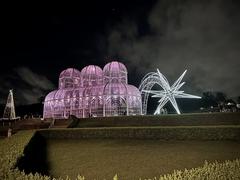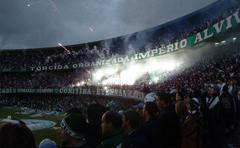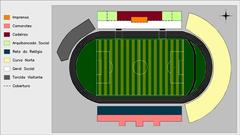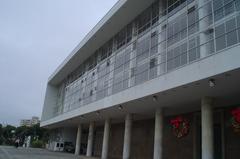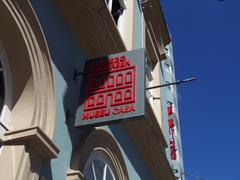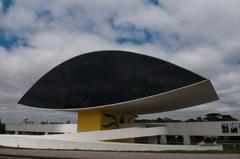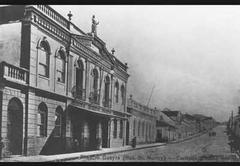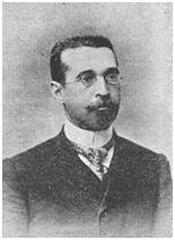
Wire Opera House Visiting Hours, Tickets, and Guide to Curitiba Historical Sites
Date: 04/07/2025
Introduction
Nestled within the lush Parque das Pedreiras in Curitiba, Brazil, the Wire Opera House (Ópera de Arame) is an architectural marvel and a vibrant center for the city’s cultural life. Since its inauguration in 1992, this unique venue has captivated visitors with its innovative use of steel tubes and transparent polycarbonate panels, creating a structure that seems to float above an artificial lake within a former rock quarry. Conceived by architect Domingos Bongestabs, the Wire Opera House exemplifies modern architecture’s harmonious integration with nature and reflects Curitiba’s pioneering spirit in urban renewal and environmental sustainability (Curitiba Official Tourism; ArchDaily).
Beyond its architectural significance, the Wire Opera House symbolizes Curitiba’s dedication to culture, accessibility, and community engagement. The venue’s transparent design blurs the boundaries between audience and environment, providing an immersive sensory experience. From classical concerts and theater to festivals and community events, the Wire Opera House stands as a testament to urban regeneration and sustainable cultural development (Wikipedia; Touristlink).
This detailed guide covers the history, architecture, visiting hours, ticketing, accessibility, travel tips, and nearby attractions. It will help you plan your visit and experience one of Brazil’s most iconic cultural sites (Ópera de Arame Official; Headfirst Travel).
History and Transformation
From Quarry to Cultural Landmark
The Wire Opera House stands as a symbol of Curitiba’s innovative urban planning. Built on the site of a disused rock quarry in Parque das Pedreiras, the area was transformed from an abandoned industrial scar to a thriving cultural space in 1992 (HelloTravel). The reclamation of this landscape exemplifies Curitiba’s approach to sustainable development and creative land use (Headfirst Travel).
Construction and Design
Domingos Bongestabs, also renowned for the city’s UNILIVRE, designed the opera house to blend seamlessly with its natural surroundings. Built in just 75 days, its structure is composed of approximately 360 tons of steel tubes and transparent polycarbonate panels, ensuring both durability and minimal environmental impact (Wikipedia; ArchDaily). The circular plan, partially surrounded by an artificial lake, is accessed by a dramatic walkway that enhances the sense of anticipation for visitors (Matraqueando).
Early Years and Renovations
After its inauguration on March 18, 1992, the Wire Opera House quickly garnered acclaim for its acoustics and innovative design. The venue originally seated up to 2,400 people, but renovations in 2006 reduced capacity to around 1,000 for improved comfort and safety (HelloTravel). Despite these adjustments, the signature transparent roof and open walls remain, creating an ever-changing interplay of light and shadow (MonkeysTale).
Architectural Significance
Design Philosophy
The Wire Opera House’s design embodies transparency and accessibility, with its steel-and-polycarbonate structure providing uninterrupted views of the surrounding landscape. The use of prefabricated components allowed rapid, low-impact construction (Curitiba Official Tourism; ArchDaily).
Integration with Nature
Hovering above an artificial lake and encircled by the Atlantic Forest, the building’s circular footprint and elevated walkways ensure minimal disturbance to the natural environment (Curitiba Official Tourism). The polycarbonate panels maximize natural light and maintain a strong visual connection with the outdoors.
Spatial Layout and Acoustics
The auditorium accommodates approximately 1,000–1,572 spectators (depending on configuration), with tiered seating and a column-free interior supported by steel trusses (Curitiba Official Tourism; ArchDaily). The design ensures excellent acoustics, suitable for a range of performances.
Symbolic Value
As a cultural icon, the Wire Opera House represents openness, environmental stewardship, and cultural accessibility—core aspects of Curitiba’s identity (Curitiba Official Tourism; ArchDaily).
Visitor Guide
Visiting Hours and Tickets
- Hours: Tuesday to Sunday, 9:00 AM – 6:00 PM (closed Mondays; hours may vary during events).
- Tickets: General admission typically R$16.00; half-price (meia entrada) R$8.00. Curitiba residents receive free admission on Wednesdays with valid ID (excluding holidays) (Ópera de Arame Official). Tickets can be purchased at the box office (10:00 AM – 5:50 PM) or online.
Accessibility
The venue offers ramps, accessible restrooms, and seating for visitors with disabilities. The approach via the footbridge is mostly accessible, but those with mobility challenges may wish to contact the venue in advance for support (Trek Zone; Minube).
How to Get There
- Address: Rua João Gava, 920, Abranches, Curitiba, PR, CEP 82130-010.
- Transport: Best reached by car or taxi (parking available), or via public bus routes. Most visitors arrive by car (TripHobo).
Duration and Best Times to Visit
- Stay Length: Most visitors spend 30–60 minutes; longer if attending performances or enjoying on-site amenities.
- Best Time: Early mornings or late afternoons for optimal lighting and fewer crowds.
On-Site Amenities
- Café & Restaurant: Enjoy local cuisine and scenic views.
- Restrooms: Available throughout the complex.
- Gift Shop: Offers unique souvenirs.
- Parkland: Ideal for walks, birdwatching, and photography.
Travel Tips and Nearby Attractions
- Footwear: Wear comfortable, flat shoes; avoid heels and skirts due to the structure of the walkways (Minube).
- Photography: The venue is exceptionally photogenic, especially during golden hour.
- Weather: Some areas are exposed; bring an umbrella or raincoat if needed.
- Nearby Attractions: Explore the adjacent Pedreira Paulo Leminski (concert venue), Oscar Niemeyer Museum, Parque Tanguá, and Largo da Ordem for a comprehensive Curitiba cultural experience (Trek Zone; Travel2Concert).
Cultural and Community Impact
The Wire Opera House is a vital component of Curitiba’s cultural life, hosting concerts, theater, festivals, and community events. It attracts over 340,000 visitors annually and serves as a gathering point for both locals and tourists (Ópera de Arame Official). The transformation from quarry to cultural landmark is a model of urban regeneration, sustainability, and civic pride (Touristlink; Best Time to Visit Curitiba).
Frequently Asked Questions (FAQ)
Q: What are the regular visiting hours?
A: Tuesday to Sunday, 9:00 AM to 6:00 PM. Closed on Mondays.
Q: Where can I buy tickets?
A: At the venue’s box office (10:00 AM–5:50 PM) or online via the official website (Ópera de Arame Official).
Q: Is the venue accessible for people with disabilities?
A: Yes, with ramps, accessible seating, and restrooms.
Q: Are guided tours available?
A: Yes, check the official event calendar for availability.
Q: What else can I do nearby?
A: Visit Pedreira Paulo Leminski, Oscar Niemeyer Museum, Parque Tanguá, and explore the city’s parks and historic areas.
Visitor Feedback
Guests praise the Wire Opera House for its breathtaking design, tranquil lakeside setting, and acoustically impressive performances (Minube). Reviews often mention the seamless blend of architecture and nature, as well as the welcoming staff and vibrant cultural atmosphere (Accor).
Summary & Recommendations
The Wire Opera House is a must-see for anyone visiting Curitiba. Its transparent, steel-and-polycarbonate design set amid reclaimed natural beauty offers a rare combination of artistic expression, sustainability, and community engagement (Curitiba Official Tourism; Travel2Concert). With accessible visiting hours, reasonable ticket prices, and nearby cultural highlights, the venue is ideal for both spontaneous visits and planned cultural outings. For an enhanced experience, check event schedules, consider a guided tour, and explore the surrounding attractions. Downloading the Audiala app ensures you’ll have the latest event updates and exclusive offers.
Sources and Further Reading
- Wire Opera House, Wikipedia
- Wire Opera House in Curitiba: History, Architecture, Visiting Hours, Tickets & Tips for Visitors, Headfirst Travel
- Wire Opera House (Ópera de Arame), Curitiba Official Tourism
- Wire Opera House Architectural Details, ArchDaily
- Wire Opera House Visiting Hours, Tickets, and Guide, Touristlink
- Wire Opera House Official Website, Ópera de Arame Official
- Wire Opera House Visitor Guide, Trek Zone
- Wire Opera House Cultural Programming and Impact, Travel2Concert
- Wire Opera House Visitor Feedback, Minube
- Curitiba Brazilian Pop Concerts, Accor
- Best Time to Visit Curitiba












